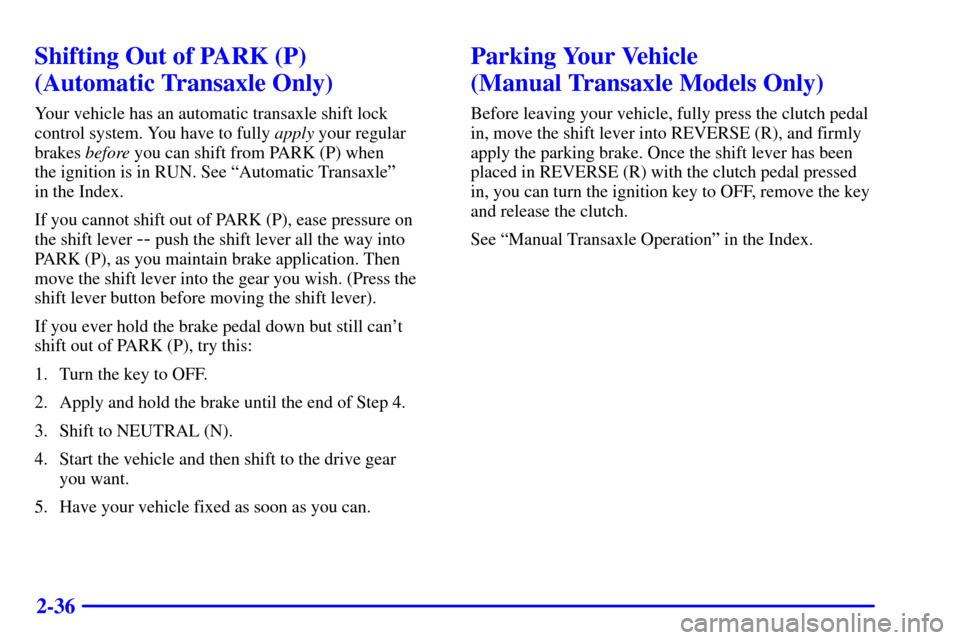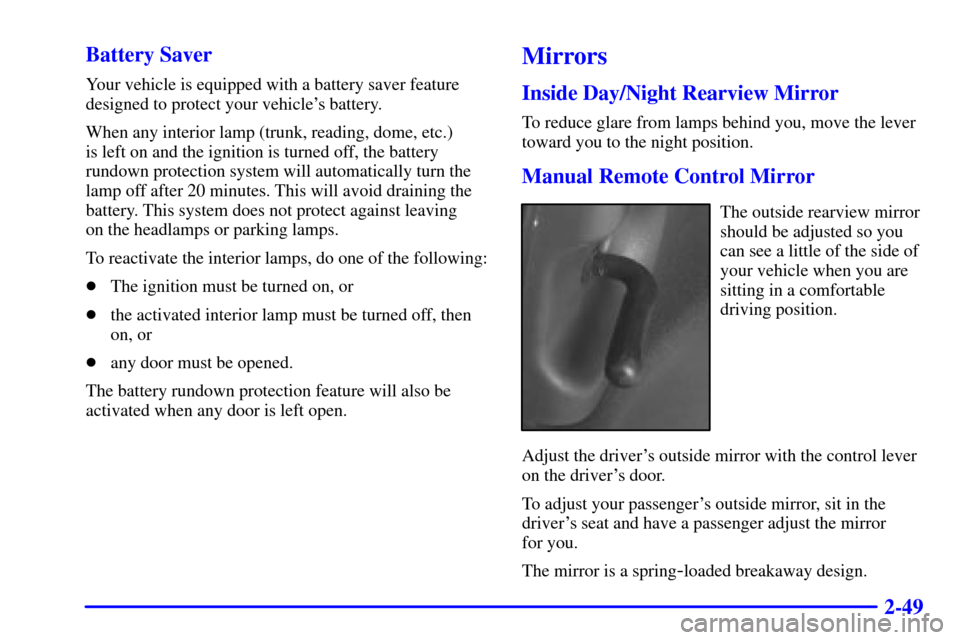Page 85 of 360

2-24 Starting Your 2.4L L4 (LD9) Engine
1. With your foot off the accelerator pedal, turn your
ignition key to START. When the engine starts, let
go of the key. The idle speed will go down as your
engine warms up.
NOTICE:
Holding your key in START for longer than
15 seconds at a time will cause your battery to
be drained much sooner. And the excessive heat
can damage your starter motor. Wait about
15 seconds between each try to help avoid
draining your battery or damaging your starter.
2. If the engine doesn't start in 10 seconds, or if the
weather is very cold (below
-20� F or -29� C),
push the accelerator pedal about one
-quarter of the
way down while you turn the key to START. Do this
until the engine starts. As soon as it does, let go of
the key.3. If your engine still won't start (or starts but then
stops), it could be flooded with too much gasoline.
Try pushing your accelerator pedal all the way to the
floor and holding it there as you hold the key in
START for a maximum of 15 seconds. This clears
the extra gasoline from the engine. If the engine still
won't start or starts briefly but then stops again,
repeat Step 1 or 2, depending on temperature.
When the engine starts, release the key and the
accelerator pedal.
NOTICE:
Your engine is designed to work with the
electronics in your vehicle. If you add electrical
parts or accessories, you could change the way
the engine operates. Before adding electrical
equipment, check with your dealer. If you don't,
your engine might not perform properly.
Page 88 of 360

2-27
Automatic Transaxle Operation
If your vehicle is equipped with an automatic
transaxle, the shift lever is located on the console
between the seats.
There are seven positions for the four
-speed automatic
transaxle. See ªForward Gearsº later in this section.
PARK (P): This position locks your front wheels. It's
the best position to use when you start your engine
because your vehicle can't move easily.
CAUTION:
It is dangerous to get out of your vehicle if the
shift lever is not fully in PARK (P) with the
parking brake firmly set. Your vehicle can roll.
Don't leave your vehicle when the engine is
running unless you have to. If you have left the
engine running, the vehicle can move suddenly.
CAUTION: (Continued)
CAUTION: (Continued)
You or others could be injured. To be sure your
vehicle won't move, even when you're on fairly
level ground, always set your parking brake and
move the shift lever to PARK (P).
See ªShifting Into PARK (P)º in the Index.
If you're pulling a trailer, see ªTowing a Trailerº
in the Index.
Ensure the shift lever is fully in PARK (P) before
starting the engine. Your vehicle has an automatic
transaxle shift lock control system. You have to fully
apply your regular brakes before you can shift from
PARK (P) when the ignition key is in RUN. If you
cannot shift out of PARK (P), ease pressure on the shift
lever
-- push the shift lever all the way into PARK (P)
and also release the shift lever button on floor shift
console models as you maintain brake application. Then
move the shift lever into the gear you wish. (Press the
shift lever button before moving the shift lever.) See
ªShifting Out of PARK (P)º in the Index.
Page 94 of 360
2-33
Parking Brake
Manual shown, Automatic similar
The parking brake lever is located between the
bucket seats.To set the parking brake, hold the brake pedal down and
pull up on the parking brake lever. If the ignition is on,
the brake system warning light will come on.
To release the parking brake, hold the brake pedal down.
Pull the parking brake lever up until you can press the
release button. Hold the release button in as you move
the brake lever all the way down.
If you forget to release your parking brake prior to
driving away, a chime will sound to remind you to
release the parking brake.
NOTICE:
Driving with the parking brake on can cause
your rear brakes to overheat. You may have to
replace them, and you could also damage other
parts of your vehicle.
Page 95 of 360
2-34
Shifting Into PARK (P)
(Automatic Transaxle Only)
CAUTION:
It can be dangerous to get out of your vehicle if
the shift lever is not fully in PARK (P) with the
parking brake firmly set. Your vehicle can roll. If
you have left the engine running, the vehicle can
move suddenly. You or others could be injured.
To be sure your vehicle won't move, even when
you're on fairly level ground, use the steps that
follow. If you're pulling a trailer, see ªTowing a
Trailerº in the Index.
1. Hold the brake pedal down and set the
parking brake.
2. Move the shift lever into the PARK (P) position
like this:
�Hold in the button on the shift lever.
�Push the lever all the way toward the front of
your vehicle.
3. Turn the ignition key to LOCK.
4. Remove the key and take it with you. If you can
leave your vehicle with the ignition key in your
hand, your vehicle is in PARK (P).
Page 97 of 360

2-36
Shifting Out of PARK (P)
(Automatic Transaxle Only)
Your vehicle has an automatic transaxle shift lock
control system. You have to fully apply your regular
brakes before you can shift from PARK (P) when
the ignition is in RUN. See ªAutomatic Transaxleº
in the Index.
If you cannot shift out of PARK (P), ease pressure on
the shift lever
-- push the shift lever all the way into
PARK (P), as you maintain brake application. Then
move the shift lever into the gear you wish. (Press the
shift lever button before moving the shift lever).
If you ever hold the brake pedal down but still can't
shift out of PARK (P), try this:
1. Turn the key to OFF.
2. Apply and hold the brake until the end of Step 4.
3. Shift to NEUTRAL (N).
4. Start the vehicle and then shift to the drive gear
you want.
5. Have your vehicle fixed as soon as you can.
Parking Your Vehicle
(Manual Transaxle Models Only)
Before leaving your vehicle, fully press the clutch pedal
in, move the shift lever into REVERSE (R), and firmly
apply the parking brake. Once the shift lever has been
placed in REVERSE (R) with the clutch pedal pressed
in, you can turn the ignition key to OFF, remove the key
and release the clutch.
See ªManual Transaxle Operationº in the Index.
Page 106 of 360
2-45
Using Cruise Control on Hills
How well your cruise control will work on hills depends
upon your speed, load and the steepness of the hills.
When going up a steep hill, you may have to step on the
accelerator pedal to maintain your speed. When going
downhill, you may have to brake or shift to a lower gear
to keep your speed down. Of course, applying the brake
or clutch pedal takes you out of cruise control. Many
drivers find this to be too much trouble and don't use
cruise control on steep hills.
Ending Cruise Control
There are several ways to turn off the cruise control:
�Step lightly on the brake pedal, or push the clutch
pedal, if you have a manual transaxle, or
�move the cruise switch to OFF.
Erasing Cruise Speed Memory
When you turn off the cruise control or the ignition,
your cruise control set speed memory is erased.Exterior Lamps
The exterior lamp band on the turn signal/multifunction
lever controls the exterior lamps.
Page 107 of 360

2-46
The exterior lamp band has three positions:
OFF: Turning the band to this position turns off all
lamps, except the Daytime Running Lamps (DRL).
(Parking Lamps): Turning the band to this position
turns on the parking lamps, together with the following:
�Sidemarker Lamps
�Taillamps
�Instrument Panel Lights
(Headlamps): Turning the band to this position
turns on the headlamps, together with the previously
listed lamps and lights.
Lamps On Reminder
If you open the driver's door with the ignition off and
the lamps on, you will hear a warning chime.
Daytime Running Lamps
Daytime Running Lamps (DRL) can make it easier for
others to see the front of your vehicle during the day.
DRL can be helpful in many different driving
conditions, but they can be especially helpful in the
short periods after dawn and before sunset. Fully
functional daytime running lamps are required on all
vehicles first sold in Canada.
The DRL system will make your high and low
-beam
headlamps come on at a reduced brightness in daylight
when the following conditions are met:
�The ignition is on,
�the exterior lamp band is in OFF or in the parking
lamp position,
�the parking brake is released, and
�the transaxle is not in PARK (P) on models with an
automatic transaxle only.
Page 110 of 360

2-49 Battery Saver
Your vehicle is equipped with a battery saver feature
designed to protect your vehicle's battery.
When any interior lamp (trunk, reading, dome, etc.)
is left on and the ignition is turned off, the battery
rundown protection system will automatically turn the
lamp off after 20 minutes. This will avoid draining the
battery. This system does not protect against leaving
on the headlamps or parking lamps.
To reactivate the interior lamps, do one of the following:
�The ignition must be turned on, or
�the activated interior lamp must be turned off, then
on, or
�any door must be opened.
The battery rundown protection feature will also be
activated when any door is left open.
Mirrors
Inside Day/Night Rearview Mirror
To reduce glare from lamps behind you, move the lever
toward you to the night position.
Manual Remote Control Mirror
The outside rearview mirror
should be adjusted so you
can see a little of the side of
your vehicle when you are
sitting in a comfortable
driving position.
Adjust the driver's outside mirror with the control lever
on the driver's door.
To adjust your passenger's outside mirror, sit in the
driver's seat and have a passenger adjust the mirror
for you.
The mirror is a spring
-loaded breakaway design.